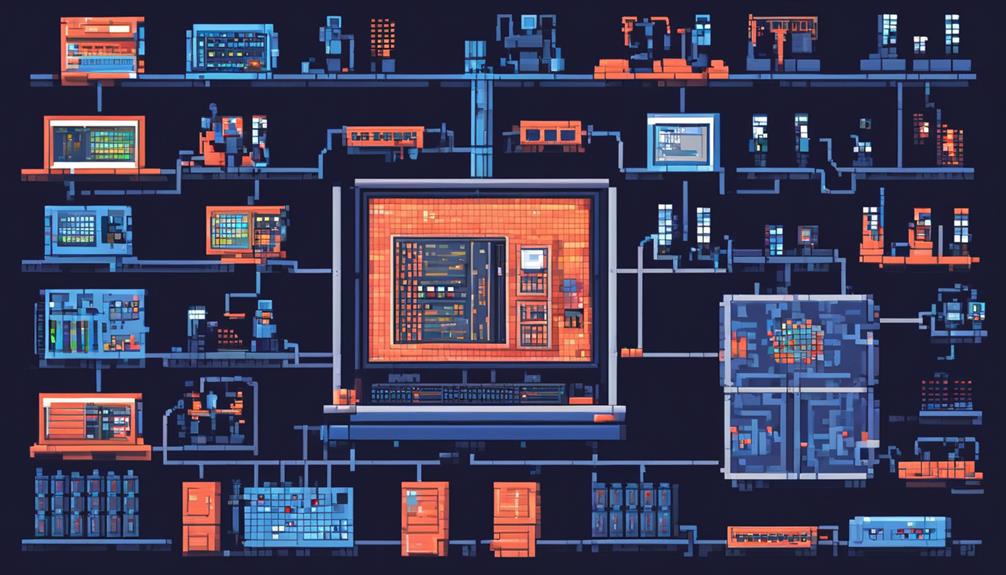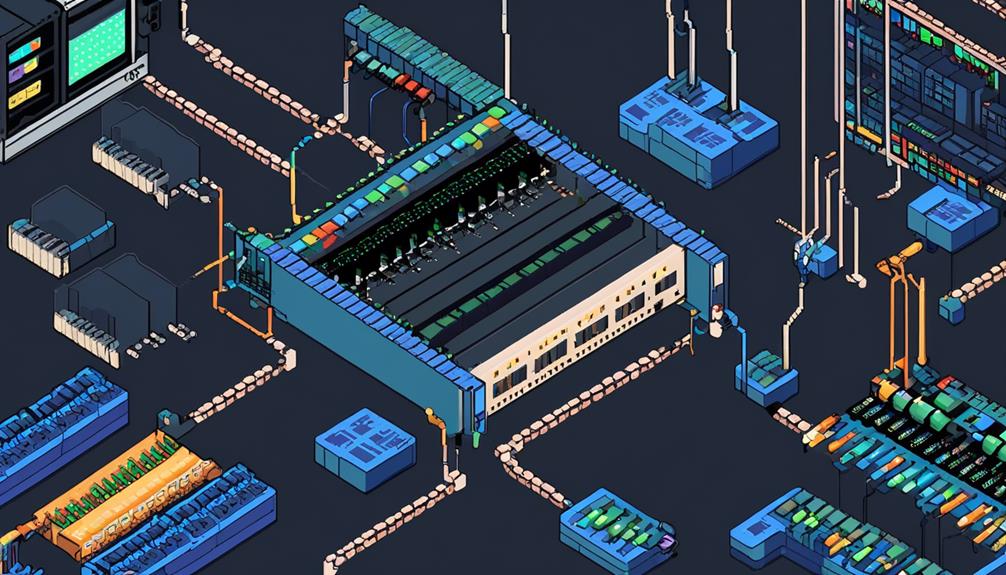Network Access Control (NAC) is a critical component in ensuring the security and integrity of a network. However, implementing effective NAC requires the use of hardware that can enforce access control policies and protect against unauthorized access.
From switches and routers to firewalls and authentication servers, the hardware for NAC plays a vital role in safeguarding sensitive data and preventing security breaches.
In this discussion, we will explore the various aspects of NAC hardware, including its benefits, factors to consider when choosing the right hardware, and its applications in different network environments.
By understanding the importance and functionality of NAC hardware, organizations can make informed decisions to enhance their network security and maintain compliance with industry regulations.
Stay tuned to discover the latest trends and advancements in NAC hardware technology that will shape the future of network security.
Key Takeaways
- NAC hardware plays a vital role in enforcing access control policies and protecting against unauthorized access, ensuring the security of sensitive data and preventing security breaches.
- It provides network visibility and control, allowing for effective management and tracking of devices and users accessing the network.
- NAC hardware mitigates security risks by enforcing access control policies, preventing noncompliant devices from compromising the network, and verifying compliance with security requirements.
- When choosing NAC hardware, factors such as scalability, integration capabilities, performance and throughput, deployment flexibility, and centralized management should be considered.
Network Access Control Hardware Overview

The Network Access Control Hardware Overview provides a comprehensive understanding of the critical role that NAC hardware plays in implementing access control policies and enforcing security measures on corporate networks. NAC solutions are designed to provide network visibility and control over devices and users accessing the network. This hardware acts as a gatekeeper, ensuring that only authorized devices and users are granted access while preventing unauthorized entities from compromising the network's security infrastructure.
NAC hardware plays a vital role in managing and securing the increasing influx of mobile devices accessing corporate networks. With the proliferation of mobile devices and the Internet of Things (IoT), NAC hardware solutions are essential in mitigating security risks associated with these devices. By implementing NAC hardware, organizations can define and enforce access policies, evaluate security posture, and respond effectively to network threats.
The primary function of NAC hardware is policy enforcement. It ensures that devices and users comply with the organization's security policies before granting access to the network. This enforcement can include verifying the presence of antivirus software, checking for updated operating systems, and validating user credentials.
Moreover, NAC hardware provides network visibility, allowing organizations to monitor and track devices and users accessing the network. This visibility enables organizations to detect and respond promptly to any abnormalities or security incidents, enhancing overall network security.
Benefits of Implementing NAC Hardware
Implementing NAC hardware offers enhanced network security by providing organizations with visibility, control, and compliance capabilities. It improves access control by preventing noncompliant devices from compromising the network, strengthening overall security infrastructure.
Additionally, implementing NAC hardware increases network visibility, enabling organizations to effectively manage the exponential growth of mobile devices accessing networks and mitigate associated security risks.
Enhanced Network Security
Enhanced network security is achieved through the implementation of Network Access Control (NAC) hardware. This hardware effectively prevents noncompliant devices from compromising the network and reinforces overall network protection against unauthorized access and cyber threats. The benefits of implementing NAC hardware for enhanced network security can be summarized as follows:
- Mitigates security risks associated with the exponential growth of mobile devices accessing networks. NAC hardware ensures that only authorized and secure devices are allowed access, thereby reducing the risk of unauthorized access and potential security breaches.
- Provides comprehensive protection against unauthorized access by enforcing access control policies. NAC hardware ensures that only authenticated users and devices are granted network access, preventing unauthorized individuals or devices from gaining entry.
- NAC hardware strengthens network infrastructure security by continuously monitoring and evaluating devices' compliance with security policies. This process helps to identify and isolate noncompliant devices, reducing the potential for network threats and vulnerabilities.
- Enhances device security by ensuring that devices meet security requirements before being allowed access to the network. By verifying compliance with security policies, NAC hardware helps to reduce the risk of malware infection and data breaches.
Improved Access Control
Improved access control is one of the key benefits that can be achieved through the implementation of Network Access Control (NAC) hardware. NAC hardware enhances visibility and compliance by effectively managing and enforcing network access policies. It prevents noncompliant devices from compromising network security, reducing the risk of unauthorized access and potential security breaches.
NAC hardware strengthens the overall security infrastructure by providing real-time visibility and control over network endpoints. With the exponential growth of mobile devices accessing networks, NAC hardware plays a critical role in mitigating security risks associated with these devices.
Additionally, NAC hardware provides the capability to customize and manage guest networking access, ensuring secure and controlled guest network privileges. By implementing NAC hardware, organizations can have better control over their network access, enforce access control list policies, and manage devices effectively.
Increased Network Visibility
With the implementation of Network Access Control (NAC) hardware, organizations can gain a deeper understanding of their network by achieving increased visibility into all devices accessing it. This increased network visibility is essential for effective network management and security.
Here are the benefits of implementing NAC hardware for increased network visibility:
- Identification and Profiling: NAC hardware allows organizations to identify and profile users and devices connecting to the network. This provides insights into their behavior and security posture, enabling better decision-making regarding network access.
- Mitigating Security Risks: Increased network visibility through NAC hardware helps mitigate security risks associated with the growing number of mobile and IoT devices accessing the network. Organizations can identify and block unauthorized or noncompliant devices, ensuring only trusted devices connect to the network.
Factors to Consider When Choosing NAC Hardware
When selecting NAC hardware, it is crucial to carefully consider various factors that will ensure optimal performance and seamless integration with the organization's network and security infrastructure.
Scalability is one such important factor. The hardware should have the ability to scale with the organization's network growth, accommodating an increasing number of devices and users without compromising performance.
Integration capabilities are also essential. The hardware should be compatible with existing networking and security tools, such as Cisco Identity Services Engine (ISE), Aruba ClearPass Policy, Sophos NAC, Barracuda CloudGen, and Palo Alto Networks, to enable seamless integration and centralized management.
Performance and throughput are critical considerations. The NAC hardware should have sufficient performance and throughput capacity to handle the network's requirements, ensuring smooth and uninterrupted operation.
Deployment flexibility is another factor to consider. The hardware should offer various deployment options like on-premise, cloud-based, or hybrid solutions, allowing organizations to choose the most suitable deployment model based on their specific needs and preferences.
Vendor support and maintenance are also essential factors to evaluate. The chosen vendor should provide reliable support services and maintenance options for the NAC hardware, ensuring prompt assistance and resolution of any issues that may arise.
NAC Hardware for Small Businesses

NAC hardware for small businesses offers cost-effective solutions that address the specific needs and budget constraints of smaller networks. These hardware options provide scalability, allowing businesses to easily expand their network while maintaining control and security.
Furthermore, the easy installation and management of these hardware solutions simplify the implementation process and enable small businesses to efficiently enforce policies and respond to potential threats.
Cost-Effective NAC Solutions
Cost-effective NAC hardware solutions are paramount for small businesses seeking to implement efficient network access control, visibility, and compliance. By investing in cost-effective NAC solutions, small businesses can ensure secure access to their network, protect sensitive data, and prevent unauthorized devices from compromising network security.
Here are two key benefits of cost-effective NAC solutions for small businesses:
- Strengthened Network Security:
- NAC hardware prevents noncompliant devices from infecting the network, thus strengthening the overall network security infrastructure.
- These solutions are essential for managing the increasing number of mobile devices accessing small business networks and help mitigate associated security risks.
- Enhanced Network Management:
- Small businesses can utilize NAC hardware for guest networking access through customizable portals.
- NAC hardware also allows businesses to evaluate security-policy compliance through security posture checks.
Scalable Hardware Options
To address the network access control needs of small businesses, scalable hardware options play a crucial role in ensuring efficient management and security without straining the infrastructure.
NAC hardware solutions for small businesses offer flexibility in the form of appliances and virtual machines, allowing for tailored implementation based on business requirements and network demands.
These hardware options enable small businesses to efficiently manage network access and security without overburdening their infrastructure.
Moreover, NAC hardware for small businesses is designed to be cost-effective, ensuring that network security measures remain within budget constraints.
Choosing the right NAC hardware involves assessing the organization's current and future network access control needs to ensure scalable and effective solutions.
Easy Installation and Management
Easy installation and management are key features of NAC hardware designed specifically for small businesses, simplifying deployment and ongoing maintenance. These features make it easier for small businesses to implement and manage their network access control systems.
Here are some reasons why easy installation and management are important for small businesses:
- Intuitive user interface and straightforward configuration enable quick setup and operation. This means that businesses can get their NAC systems up and running without spending too much time on complex configurations.
- Streamlined management tools minimize the need for dedicated IT resources, reducing operational costs. Small businesses often have limited IT staff, so having NAC hardware that is easy to manage helps them save time and money.
- Scalable options accommodate the growing needs of small businesses without complex infrastructure changes. As the business grows, the NAC hardware can easily be expanded or upgraded to meet the increased demand.
- Automated updates and maintenance ensure the NAC hardware stays current and secure with minimal effort. This reduces the burden on small businesses to manually update and maintain their NAC systems, allowing them to focus on other important tasks.
NAC Hardware for Enterprise Networks

NAC Hardware for Enterprise Networks plays a critical role in enhancing network security infrastructure by preventing noncompliant devices from infecting the network. With the exponential growth of mobile devices accessing enterprise networks, these hardware solutions are essential for managing and securing the network effectively.
NAC hardware provides organizations with visibility, access control, and compliance tools to ensure that only authorized and compliant devices are allowed access. These hardware solutions work in conjunction with NAC software to enforce network policies and ensure that all devices meet the required security standards before granting access.
One of the key benefits of NAC hardware is its ability to mitigate security risks brought by the increasing number of mobile devices accessing enterprise networks. By implementing NAC hardware, organizations can identify and block devices that do not comply with security protocols, reducing the risk of malware infections and unauthorized access.
Furthermore, NAC hardware solutions offer granular control over network access, allowing organizations to define and enforce policies based on user roles, device types, and security postures. This ensures that only devices with the necessary security controls are granted access to sensitive data and resources.
In addition to securing the network, NAC hardware also provides organizations with comprehensive reporting and auditing capabilities. This allows them to monitor network activity, track compliance status, and generate detailed reports for regulatory purposes.
Types of NAC Hardware Solutions
When it comes to NAC hardware solutions, there are several options available.
NAC appliances offer a dedicated hardware solution that can be deployed in the network infrastructure. This provides a centralized approach to network access control.
Another option is network switch integration, where NAC functionality is built directly into network switches, allowing for seamless enforcement of access policies.
Additionally, endpoint security solutions can be utilized to complement NAC hardware, providing an extra layer of protection by securing individual devices.
These different types of NAC hardware solutions offer organizations flexibility in designing and implementing an effective network access control strategy.
NAC Appliance Options
Various types of NAC hardware solutions, including specialized options like Cisco Identity Services Engine (ISE) and Industrial Network Director, cater to a wide range of network infrastructure needs while addressing unique security requirements.
These NAC appliance options provide organizations with the necessary tools to enforce network access control policies, secure remote access, and enhance overall network security. Some key features of these NAC appliance options include centralized policy management, real-time visibility, and control over network endpoints.
Additionally, these hardware solutions offer specialized solutions for IoT, OT, industrial controls, and medical devices, ensuring the security of critical infrastructure and sensitive data.
Pricing for NAC appliances varies, accommodating different budget and deployment needs, with options for perpetual licenses, subscription models, and evaluation licenses.
Network Switch Integration
To seamlessly enforce access control policies, NAC hardware solutions can be integrated with existing network switches, allowing for enhanced security and monitoring capabilities at the port level.
Various NAC hardware solutions, such as Cisco Identity Services Engine (ISE), Cisco TrustSec, and Software-Defined Access, offer different approaches to switch integration. These solutions utilize technologies like 802.1X, MAC Authentication Bypass (MAB), or Web Authentication to integrate with network switches.
By integrating with network switches, NAC solutions can enforce policies based on user, device, or security posture, ensuring compliance before granting network access. This integration enhances the overall security posture by controlling and monitoring network access.
Network switch integration is a crucial component of a comprehensive network access control system, providing a secure and efficient means of identity and access management.
Endpoint Security Solutions
Endpoint security solutions are a crucial component of network security infrastructure, providing specialized capabilities for managing network access control. When it comes to NAC hardware solutions, there are several options available that cater to different needs and environments.
One category of NAC hardware solutions focuses on identity services. Cisco Identity Services Engine (ISE) is a popular choice in this category, offering comprehensive policy management and authentication capabilities. This allows organizations to enforce granular access control policies and ensure that only authorized users and devices can access the network.
Another category of NAC hardware solutions is designed specifically for IoT devices. These solutions provide enhanced security measures for the growing number of connected devices in today's networks. Cisco Industrial Network Director is an example of a hardware solution that addresses the unique requirements of industrial IoT devices, such as those found in manufacturing environments.
NAC Hardware Installation and Configuration
The installation and configuration of NAC hardware is a critical step in ensuring robust network access control and security enforcement. Proper placement and planning of hardware devices is essential to effectively enforce access control policies. During installation, NAC hardware is connected to network switches, routers, and other devices to enable the implementation of access control measures.
The configuration process involves setting up the hardware devices with appropriate security policies, user authentication methods, and network segmentation rules.
In order to achieve comprehensive security, NAC hardware installation and configuration may also involve integrating with existing network security infrastructure such as firewalls, VPNs, and Security Information and Event Management (SIEM) solutions. This integration ensures that the NAC system can effectively enforce access control policies in conjunction with other security measures.
During the installation phase, careful consideration should be given to the placement of NAC hardware devices. They should be strategically positioned to monitor and control access at critical points within the network infrastructure. This ensures that all traffic passing through these points is subjected to the access control policies defined by the NAC system.
The configuration of NAC hardware involves defining and implementing access control policies that align with the organization's security requirements. This includes specifying the authentication methods to be used, such as username and password, digital certificates, or multi-factor authentication. Additionally, network segmentation rules can be configured to enforce different levels of access for different user groups or devices.
Scalability and Performance of NAC Hardware

When considering the scalability and performance of NAC hardware, it is crucial to ensure that the system can efficiently handle the increasing network traffic and device connections while maintaining optimal access control, enforcement, and threat response.
The scalability of NAC hardware refers to its ability to handle the growing number of devices, users, and endpoints accessing the network. Here are some key considerations:
- Scalable NAC hardware: NAC hardware should be designed to support the expanding network infrastructure without compromising its performance. It should be able to handle the increasing network traffic and device connections without experiencing any degradation in performance. This ensures that access control, enforcement, and threat response can be effectively carried out even as the network grows.
- High-performance NAC hardware: The performance of NAC hardware directly impacts the speed and reliability of access control, enforcement, and threat response. High-performance NAC hardware minimizes latency and ensures real-time visibility and control over network traffic. It allows for quick and accurate decision-making regarding network access and security policies.
Efficient NAC hardware: Efficient NAC hardware is capable of handling large-scale incident response and policy enforcement without compromising network performance. It should be able to process and analyze network traffic in real-time, identify and respond to threats effectively, and enforce access control policies efficiently. This ensures that the network remains secure and accessible to authorized users without any significant impact on its performance.
Integration With Existing Network Infrastructure
Integration with existing network infrastructure is a critical aspect of implementing Network Access Control (NAC) hardware. It ensures seamless integration and compatibility with current networking equipment and systems, allowing organizations to leverage their existing investments.
This smooth migration process facilitates centralized management and control of access policies, reducing disruption to ongoing network operations.
Seamless Network Integration
Seamless network integration is a critical aspect of Network Access Control (NAC) hardware, as it allows for easy integration with existing network infrastructure. This feature enables NAC solutions to seamlessly work with current network architecture, minimizing disruption and ensuring a smooth and efficient implementation.
To achieve seamless network integration, NAC hardware leverages network segmentation techniques. This involves dividing the network into separate segments or subnets, each with its own access control policies. By implementing network segmentation, NAC solutions can enforce access control and security policies at a granular level, allowing for better control and protection of sensitive resources.
Additionally, seamless network integration ensures that NAC solutions do not hinder the functionality and performance of the current network environment. It provides a non-disruptive approach to enforcing access control and security policies, allowing organizations to maintain network access while enhancing security measures.
Compatibility With Current Infrastructure
Compatibility with current infrastructure is a crucial factor in ensuring the smooth integration of Network Access Control (NAC) solutions with existing network components. NAC solutions need to seamlessly work alongside routers, switches, and other network devices, which requires compatibility with the current network infrastructure. By integrating with the existing network, NAC solutions can leverage the existing security tools and policies in place, enhancing the overall security posture.
Moreover, compatibility with the current infrastructure allows for efficient deployment and management of NAC solutions without requiring major network overhauls. This ensures minimal disruption to network operations during NAC implementation.
The ability to integrate with the current network infrastructure is essential for NAC solutions to effectively enforce access control policies and maintain network security.
Smooth Migration Process
During the implementation of Network Access Control (NAC) solutions, ensuring a smooth migration process involves seamlessly incorporating the NAC capabilities into the existing network infrastructure. This allows organizations to gradually adapt NAC capabilities without disrupting current network operations. Smooth migration minimizes service downtime and network disruptions during the adoption of NAC systems.
To achieve a smooth migration process, organizations can leverage solutions such as the Cisco Identity Services Engine (ISE). The Cisco ISE provides a centralized platform for managing access policies and enforcing them across network devices. It enables organizations to define and enforce granular access controls based on user access, device type, and location.
With the Cisco ISE, organizations can gradually transition security policies and access controls to align with NAC requirements. This ensures the compatibility and integration of NAC capabilities with the existing network infrastructure, preserving legacy systems and configurations. By following a structured migration approach, organizations can successfully implement NAC solutions while maintaining network continuity and security.
NAC Hardware for Wireless Networks
NAC hardware for wireless networks plays a crucial role in ensuring secure access control for mobile devices connecting to the network. These hardware solutions provide visibility and control over wireless access points and connected devices, allowing organizations to enforce security policies and conduct security posture checks for devices connecting wirelessly.
With the increasing adoption of IoT devices and the proliferation of wireless networks, it is essential to have robust NAC hardware in place to mitigate security risks and ensure compliance with organizational security policies.
One of the primary challenges in securing wireless networks is the presence of devices without proper identity or security measures. NAC hardware addresses this issue by implementing authentication mechanisms that require devices to prove their identity and adhere to the organization's security policies before gaining access. This ensures that only authorized and secure devices can connect to the network, reducing the risk of unauthorized access and potential breaches.
Additionally, NAC hardware for wireless networks offers scalability to accommodate the growing number of mobile devices accessing the network. It can handle the increased traffic and effectively manage access control for a large number of devices simultaneously. This scalability is crucial in today's mobile-centric world, where organizations need to support a wide range of devices connecting wirelessly.
Furthermore, NAC hardware provides real-time monitoring and visibility into the wireless network, allowing organizations to identify and respond to potential security threats quickly. It enables continuous monitoring of devices and their compliance with security policies, ensuring that any non-compliant or compromised devices are isolated from the network to prevent further damage.
NAC Hardware for Wired Networks

With the foundation of NAC hardware for wireless networks established, it is now imperative to explore the realm of NAC hardware for wired networks. NAC hardware for wired networks provides physical control points to regulate access to the network. These devices, such as switches, routers, and gateways, are equipped with NAC capabilities that authenticate, authorize, and enforce policies for wired connections.
To understand the significance of NAC hardware for wired networks, let's delve into its key features and benefits:
- Enforcing security: NAC hardware for wired networks plays a crucial role in enforcing security measures. By authenticating and authorizing devices before granting them access, it ensures only authorized devices can connect to the network. This prevents unauthorized access and potential security breaches.
- Integration with network devices: NAC hardware for wired networks seamlessly integrates with existing network infrastructure. By leveraging protocols such as IEEE 802.1X and RADIUS, these hardware solutions can integrate with switches and routers, allowing for centralized policy enforcement and management.
- Access based on device: NAC hardware for wired networks enables access control based on device attributes. It can verify the device's identity, check its compliance with security policies, and determine its level of access accordingly. This granular control enhances the overall security posture of the network.
- Enforce policies: NAC hardware for wired networks enforces policies defined by the organization. It can restrict access to certain resources, enforce encryption standards, and ensure devices are up to date with security patches. By consistently enforcing policies, network administrators can maintain a secure and compliant network environment.
NAC Hardware for Cloud-based Environments
In cloud-based environments, NAC hardware plays a critical role in ensuring secure access control for devices connecting to cloud resources. These hardware solutions enable organizations to enforce policies and security measures for cloud network access, providing real-time visibility and control over devices connecting to cloud infrastructure. NAC hardware for cloud-based environments helps prevent unauthorized access and secure cloud resources.
One example of NAC hardware for cloud environments is OPSWAT MetaAccess. This solution integrates with cloud platforms such as Amazon Web Services (AWS) to ensure compliance and mitigate security risks in cloud-based networks. It offers agentless device identification, allowing organizations to identify and authenticate devices connecting to their cloud resources without the need for installing additional software agents.
Another popular NAC hardware solution for cloud-based environments is Cisco ISE. It provides comprehensive access control and security policy enforcement across cloud networks. Cisco ISE integrates with various cloud platforms and offers advanced features such as identity-based access control, network segmentation, and threat detection.
In cloud-based environments, NAC hardware is crucial for securing access to cloud resources and protecting against potential threats. With the increasing adoption of cloud services and the rise of industrial IoT (IIoT) devices, organizations need robust NAC hardware solutions to ensure the security of their cloud networks. These solutions provide the necessary visibility, control, and enforcement capabilities to protect sensitive data and resources in cloud-based environments.
NAC Hardware for Remote Access

Remote access NAC hardware provides secure and controlled network access for remote users and devices. It plays a crucial role in ensuring that remote employees can securely connect to the corporate network from any location.
Here are the key features and benefits of NAC hardware for remote access:
- Robust authentication and authorization: NAC hardware for remote access offers powerful authentication mechanisms, such as multi-factor authentication, to verify the identity of remote users. This helps prevent unauthorized access to the network and ensures that only authorized individuals can connect remotely.
- Compliance with security policies: NAC hardware enforces security policies for remote devices connecting to the network. It checks for the presence of required security software, such as antivirus and firewall, and ensures that devices are up to date with the latest security patches. This helps maintain a secure network environment and mitigates the risk of compromised remote devices.
- Encryption and secure tunnels: NAC hardware provides encryption and secure tunnels for remote access, protecting sensitive data in transit. By establishing a secure connection between the remote user and the corporate network, it prevents eavesdropping and unauthorized access to data.
- Mitigation of security risks: NAC hardware for remote access helps mitigate security risks associated with remote devices accessing the network. It can quarantine devices that fail security checks or exhibit suspicious behavior, preventing them from accessing critical resources until they are deemed safe.
Future Trends in NAC Hardware Technology
As the field of network access control (NAC) hardware continues to advance, future trends are expected to focus on enhanced security through advanced authentication mechanisms, greater scalability and performance to accommodate the growing number of connected devices, integration of machine learning and AI capabilities for improved threat detection and response, emphasis on energy efficiency and sustainability in alignment with global environmental initiatives, and advancements in IoT device integration to enable comprehensive network access control for diverse device types.
One of the key future trends in NAC hardware technology is the development of advanced authentication mechanisms. This will provide enhanced security by going beyond traditional username and password authentication. Hardware-based authentication methods, such as biometric authentication or multi-factor authentication, will become more prevalent to ensure that only authorized individuals gain access to the network.
In addition, NAC hardware technology is expected to evolve to meet the increasing scalability and performance demands of modern networks. With the rapid growth of connected devices, NAC hardware will need to handle a larger number of endpoints efficiently. This scalability and performance enhancement will enable organizations to easily deploy NAC solutions in their networks without compromising network performance.
The integration of machine learning and AI capabilities into NAC hardware is another significant future trend. By leveraging these technologies, NAC hardware can better detect and respond to threats in real-time. This will enable organizations to protect their networks from rapidly evolving threats and ensure a higher level of network security.
Furthermore, future NAC hardware will put a greater emphasis on energy efficiency and sustainability. In line with global environmental initiatives, NAC hardware vendors will strive to design energy-efficient devices that consume less power without compromising performance. This not only reduces energy costs for organizations but also contributes to a greener and more sustainable future.
Lastly, advancements in IoT device integration will enable comprehensive network access control for diverse device types. As the number of IoT devices continues to grow, NAC hardware will need to support the secure onboarding and management of these devices. This will ensure that organizations can maintain control over their networks and prevent unauthorized access from IoT devices.
Frequently Asked Questions
Is NAC Hardware or Software?
NAC can be implemented as both hardware and software solutions. Hardware NAC typically consists of physical devices like switches, routers, or dedicated appliances, while software NAC is implemented through applications or virtual appliances.
Hardware-based NAC offers dedicated processing power and control, while software-based NAC provides flexibility and scalability. The choice between hardware and software NAC depends on factors such as network size, complexity, and specific organizational requirements.
Both have their advantages and challenges, and the implementation of NAC software should follow best practices to ensure effective access control. Ultimately, the decision of NAC software vs NAC hardware depends on the specific needs of the organization.
What Device Is Used for Network Access Control?
Network access control (NAC) solutions utilize various hardware devices, such as switches, routers, and firewalls, to enforce access policies. These devices work in conjunction with NAC software to monitor, control, and secure network access.
NAC hardware plays a crucial role in authenticating users and devices, inspecting traffic, and enforcing security policies. By leveraging NAC hardware, organizations can implement access control measures, restrict unauthorized devices, and safeguard their network infrastructure.
This integration of hardware and software enables organizations to effectively secure network access and ensure compliance with security protocols.
What Are NAC Devices?
NAC devices refer to hardware tools that provide visibility, access control, and compliance for organizations. Implementing NAC devices offers numerous benefits, such as strengthening network security infrastructure, preventing noncompliant devices from infecting the network, and managing the exponential growth of mobile devices accessing networks.
Common features of NAC hardware include policy lifecycle management, user and device profiling, guest networking access, security posture check, and incident response capabilities. Different types of NAC devices available include Cisco Identity Services Engine (ISE), Aruba ClearPass, Forescout Platform, and Fortinet FortiNAC.
Deploying NAC devices requires careful consideration of best practices and challenges in implementation.
How Does NAC Work Network Access Control?
Network Access Control (NAC) works by implementing policies that control access to corporate infrastructure based on authentication, endpoint configuration, or user role/identity. NAC solutions offer diverse capabilities for managing network access and security, providing visibility and profiling of devices, enforcing security posture compliance, managing guest networking access, and integrating with other security products.
NAC also offers benefits such as policy-based access control, network visibility, and threat response integration. Best practices for NAC deployment include thorough planning, network segmentation, and regular updates to ensure optimal security. Role-based access control is a key feature in NAC systems, allowing organizations to assign specific access privileges based on user roles or job functions.

